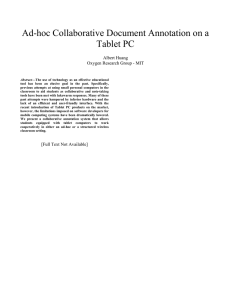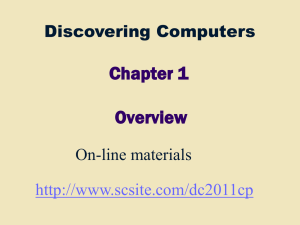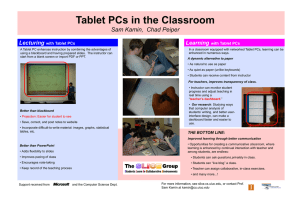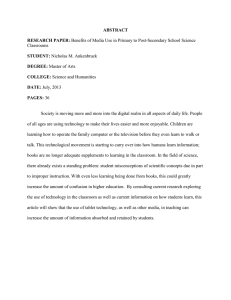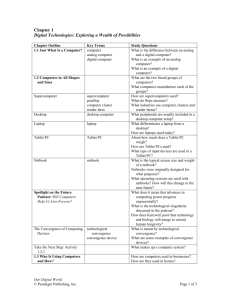Int. J. Engng Ed. Vol. 22, No. 6, pp. 1189±1196,... 0949-149X/91 $3.00+0.00 Printed in Great Britain.
advertisement
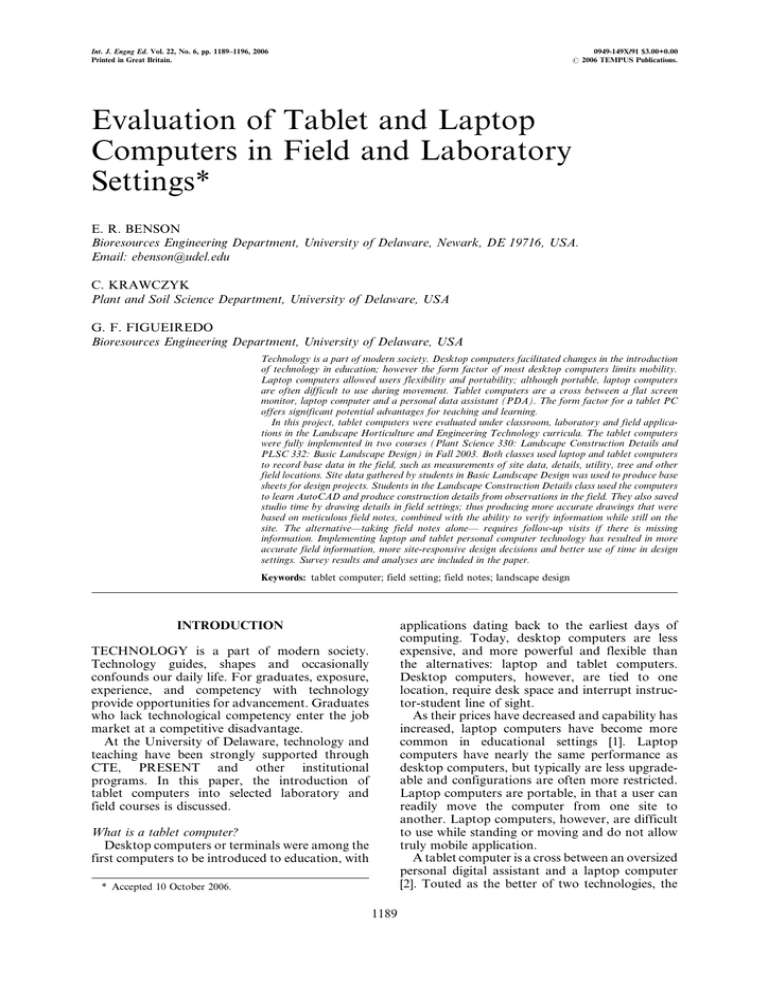
Int. J. Engng Ed. Vol. 22, No. 6, pp. 1189±1196, 2006 Printed in Great Britain. 0949-149X/91 $3.00+0.00 # 2006 TEMPUS Publications. Evaluation of Tablet and Laptop Computers in Field and Laboratory Settings* E. R. BENSON Bioresources Engineering Department, University of Delaware, Newark, DE 19716, USA. Email: ebenson@udel.edu C. KRAWCZYK Plant and Soil Science Department, University of Delaware, USA G. F. FIGUEIREDO Bioresources Engineering Department, University of Delaware, USA Technology is a part of modern society. Desktop computers facilitated changes in the introduction of technology in education; however the form factor of most desktop computers limits mobility. Laptop computers allowed users flexibility and portability; although portable, laptop computers are often difficult to use during movement. Tablet computers are a cross between a flat screen monitor, laptop computer and a personal data assistant (PDA). The form factor for a tablet PC offers significant potential advantages for teaching and learning. In this project, tablet computers were evaluated under classroom, laboratory and field applications in the Landscape Horticulture and Engineering Technology curricula. The tablet computers were fully implemented in two courses (Plant Science 330: Landscape Construction Details and PLSC 332: Basic Landscape Design) in Fall 2003. Both classes used laptop and tablet computers to record base data in the field, such as measurements of site data, details, utility, tree and other field locations. Site data gathered by students in Basic Landscape Design was used to produce base sheets for design projects. Students in the Landscape Construction Details class used the computers to learn AutoCAD and produce construction details from observations in the field. They also saved studio time by drawing details in field settings; thus producing more accurate drawings that were based on meticulous field notes, combined with the ability to verify information while still on the site. The alternativeÐtaking field notes aloneÐ requires follow-up visits if there is missing information. Implementing laptop and tablet personal computer technology has resulted in more accurate field information, more site-responsive design decisions and better use of time in design settings. Survey results and analyses are included in the paper. Keywords: tablet computer; field setting; field notes; landscape design applications dating back to the earliest days of computing. Today, desktop computers are less expensive, and more powerful and flexible than the alternatives: laptop and tablet computers. Desktop computers, however, are tied to one location, require desk space and interrupt instructor-student line of sight. As their prices have decreased and capability has increased, laptop computers have become more common in educational settings [1]. Laptop computers have nearly the same performance as desktop computers, but typically are less upgradeable and configurations are often more restricted. Laptop computers are portable, in that a user can readily move the computer from one site to another. Laptop computers, however, are difficult to use while standing or moving and do not allow truly mobile application. A tablet computer is a cross between an oversized personal digital assistant and a laptop computer [2]. Touted as the better of two technologies, the INTRODUCTION TECHNOLOGY is a part of modern society. Technology guides, shapes and occasionally confounds our daily life. For graduates, exposure, experience, and competency with technology provide opportunities for advancement. Graduates who lack technological competency enter the job market at a competitive disadvantage. At the University of Delaware, technology and teaching have been strongly supported through CTE, PRESENT and other institutional programs. In this paper, the introduction of tablet computers into selected laboratory and field courses is discussed. What is a tablet computer? Desktop computers or terminals were among the first computers to be introduced to education, with * Accepted 10 October 2006. 1189 1190 E. R. Benson et al. Fig. 1. Tablet computer. personal digital assistant and the laptop, the tablet computer combines the portability of a pad of paper with the computing power and wireless connectivity of laptop (Fig. 1). In 1988, computer visionaries projected that `the personal computer of the year 2000 will be a portable machine the size of a notebook' [3]. In theory, a tablet computer is an educator's dream [4]. Tablet computers were introduced several years ago. The graphic tablet, where the user draws on an electric board, has been around for many years. Products that combine the tablet with a computer screen have been on designers' wish lists since the late 1990's. The tablet computer, which combines the mobility of a laptop with the flexibility of a touch-sensitive drawing screen, is a recent innovation [5]. However, it was not until the recent introduction of Windows XP Tablet PC Edition was released that the technology became more feasible. While the different models vary, the portable tablet computers generally look like a bulky clipboard [2]. The user draws or writes on the screen with a special stylus and uses handwriting recognition software to interface with the system [6]. Some tablet computers are convertible, allowing the user to use the computer as a conventional laptop with keyboard, while other models only allow screen entry. The most important part of any computer is the interface with the user. Unless rapid text entry is required, the stylus is a natural way to input information [3]. Tablet computers are currently more expensive than laptops with similar features [2, 4]. Prices are, however, projected to come closer to conventional laptop prices. Several researchers are suggesting that tablet computers have the potential to revolutionize education. `Tablet computers are proving popular as PC and laptop replacements at a number of universities' [7]. Microsoft is pairing with the University of Virginia to create a pilot program that will provide wireless networking and allow students to use tablet computers to take notes electronically and access online material [8]. At other institutions, several projects have implemented tablet PC-based lecture or note taking systems [7]. Students and faculty cite tablets as quick and able to take unobtrusive note taking and cooperative design work [2]. Students appreciate mobile computing. In a pilot laptop introduction project, 63% of the students recommended laptop computers, while only 32% recommended desktop computers as a more appropriate alternative [2]. Students felt that the portability of the laptop made computer access more convenient and increased communication [9]. Students noted that they used the laptop daily, multiple times a day, and that the laptops helped to prepare them for professional work. A large number of the students (45%) did not feel that the laptop made a difference academically or socially. Hardware Designers rave about Wacom's1 Cintiq as the graphics tablet most sought after. This, however, is not mobile [5]. Timothy P. Johnson, Assistant Professor of Landscape Architecture at Penn State University, who teaches courses in digital drawing, uses both a Wacom Cintiq for studio use and a Toshiba pen-based tablet PC for mobile applications [10]. New versions made by Hewlett-Packard, Compaq, Acer, Motion, Fujitsu and Gateway are also available. The authors tested the Toshiba, Compaq and Gateway1 tablets that were available on a trial basis before purchasing the equipment for 1 Mention of trade name, proprietary product or specific equipment does not constitute a guarantee or warranty by the University of Delaware, and does not imply the approval of the named product to the exclusion of other products that may be suitable. 2 Newer models are now available. The authors reviewed the computers available at the initial stage of the project. Evaluation of Tablet and Laptop Computers their grant. They found that the Toshiba tested best of the three. It was lighter, easier to handle, and did not heat up. Johnson noted that the Toshiba offers 100 , 120 and 140 screens, (although the larger the screen, the more difficult it is to handle in mobile situations), with a resolution of 1400 6 1050 (compared to 1280 6 1024 for a graphic tablet that is not mobile). There are 256 levels of sensitivity for the stylus (compared to 512 for the Wacom Cintiq). Johnson justified this by the tablet PC's portability and convertible ability. `There is a bit of distortion,' he admitted, `but the results are still pretty good' [10]. Software One landscape architecture educator uses Sketch-up and PhotoShop as his major drawing packages. Adobe Illustrator is good for translations, he noted, and Adobe Creative Suite is certainly helpful, as is Acrobat Professional. He loaded a pen sensitivity driver, available free from Wacom from their Website, onto the Toshiba tablet PC for use with PhotoShop [10]. Sketch-up, a 3D modeling program, is also recommended by designers in Canada [11]. In the UK, OnSite View, AutoDesk's mobile CAD software Windows CE, and a mobile version of Microsoft's operating system Architectural Studio Software, are recommended. Skidmore Owings and Merrill, an architectural firm in New York City, uses Autodesk's Architectural Studio Software [5]. User interface The mouse and keyboard have become ubiquitous in computing. A keyboard is effective when stationary and a large amount of information needs to be directly entered. However, keyboards are difficult to use while standing or in the field. In addition, researchers have documented ergonomic issues associated with notebook computer keyboards, specifically citing reduced key size and spacing, the permanently attached keyboard and poor location of the pointing device [12]. For proper use, a keyboard requires an appropriate angle and support of the wrist, which are difficult to obtain in the field [13]. `Drawing with a mouse is like drawing with a bar of soap,' remarked one landscape architecture professor [14]. `Nothing beats a pen for writing or drawing,' remarked one computer visionary [3]. The tablet format will `permit the ultimate integration between text and graphics.' A mouse requires a fixed surface to properly operate, a fixed surface that is difficult to find in the field or while standing. A trackball can reduce the amount of space required, but can require some getting used to. Tablet computers use a pressure sensitive pen, which allows the user to write directly on the screen. Pen-based technology helped to enhance student cooperating at MIT robot design competition [2]. Team members would start working on a drawing in one color and send a copy to other 1191 team members, who would each make annotations on the drawing in other colors. Several pen-based computer programs have been developed for teaching. In one application, students attended class in a multimedia-enhanced classroom and the instructor used a pen system to annotate existing presentations [15]. In a different project, pen-based computers were installed at all seats of an instructional computer laboratory [7]. The tablet computers allowed students to view instructor prepared slides and take notes within the presentation. Student responses indicated that the system increased attention and encouraged its further use. Although pen-based computing has been introduced for fixed applications, little information is available on the use of pen-based computing for field or laboratory applications. Field and laboratory computing The use of computers to assist in conventional instruction is well established. The use of desktop computers in dedicated computing labs, where one or more students works in a fixed facility, is also well established for many fields. Tablet computers are convenient to use on the go. For example, a University of Texas at Austin graduate student highlighted being able to use a tablet in the middle of the field, digitizing notes directly into the tablet [2]. In landscape architecture, the ability to collect data directly or make sketches in the field would significantly increase student capability. In professional practice, mobile tablet computers allow architects and designers to take them into the client's office or onto a site: `Download the drawings onto the [tablet] before you leave the office and you have them all in your pocket when you're on site' [5]. A waterproof tablet (Mobipanel) is becoming popular with surveyors in the UK, who record directly onto it in the field. Professionals also use tablet PCs to sketch on top of CAD vector drawings. The tablet can be plugged into a mobile phone for e-mail or a large screen for presentations. Ruggedized laptop and tablet computers are being introduced for industrial applications [16]. The waterproof MobiPanel by Advantech, used by surveyors in the UK [5], is a rugged webpad that had been tested for a three foot drop test and has IP-53 dust and moisture protection [17]. Some tablet PCs have followed up on this attribute, looking for more rugged solutions for portable computing that is more cost-effective than replacing damaged equipment. Laptop Magazine recently tested industrial tablet computers `froze the notebooks, subjected them to a simulated rainstorm, baked them for an hour, and dropped them three feet onto a layer of plywood over concrete' [18] Typical markets include civil engineers, US Geological Survey, NASA, US Navy, US Coast Guard and police departments. Manufacturers' literature indicates that `if you happen to work in 1192 E. R. Benson et al. any harsh environment relating to heat, humidity, altitude, depth, or if you. . . . need a computer that would not let you down . . . then what you need is a ruggedized notebook.' Lamont Wood, of the Chicago Tribune, reported that the rugged laptop is typically `sold through business-to-business channels rather than through computer stores,' so is not as well-known as other tablet PCs. For educational use, ruggedized laptop and tablet computers may be more appropriate than the conventional consumer grade computers. What is not well documented or researched is how best to utilize computers in mobile educational settings. In particular, what type of computer is best suited to outdoor applications? How should computers be effectively introduced into changing laboratory settings? Are there individual software packages or types of software that are better suited to highly mobile settings? Tablet computers, with their advantageous form factor and true portability, offer potential advantages for field and laboratory applications. OBJECTIVES The objective of this paper is to document experiences gained with the implementation of tablet computers in selected laboratory and field settings. PROJECT METHODOLOGY Two Toshiba1 3500 Protege tablet computers were purchased during Summer 2003. The Toshiba tablet computers were configured with 496 MB RAM, a 1.33 GHz processor, wireless networking, two USB ports and a PCMCIA slot. Installed software included AutoDesk AutoCAD 2004, Microsoft Office, Microsoft Visio, National Instruments LabVIEW 6.1, JASC PaintShopPro 8.0, Adobe Illustrator 10.0.3, Photoshop 7.0.1 and Acrobat 6.0. Four existing Dell Latitude C840 laptop computers were used for comparison. Students evaluated the tablet computers during field and laboratory use to determine how the form of the computer (tablet, laptop and desktop) affected their ability to complete course tasks. Two survey instruments were developed in Fall and Spring 2004. An insufficient number of surveys were gathered to provide complete statistical comparison; however, initial numbers and comments gathered during the study are provided. The tablet computers were introduced as described below. Landscape design courses There are two methods for producing drawings in the landscape design classes offered in the Plant and Soil Science Department of the College of Agricultural and Natural Resources. The first is traditional hand drawing; the second is using computers with programs such as AutoCAD and PhotoShop. The introduction of computer technology into the landscape design curriculum was mandated in 1999. Typical students in these classes are enrolled in rigorous physical science-based coursework throughout the Landscape Horticulture major. Most of the students who take the required course in Basic Landscape Design (PLSC 332) or other design electives have little or no experience in either drawing by hand or AutoCAD. The use of computerized tools such as AutoCAD and PhotoShop help the students produce more professional-looking drawings in a quicker manner than through drawing by hand. Recent advances in software, however, have made the computer an easier tool to master. The pressure-sensitive LCD tablets can act as both a monitor for an existing computer, and as a sketchbook, because they are also developed with graphics in mind. Pressure sensitive LCD tablets also have the capability for being used in field situations, although they are not being used for such purposes in design courses in US universities. In this project, we evaluated the use of tablet computers for design and drawing. Courses such as Basic Landscape Design (PLSC 332), Landscape Construction Systems (PLSC 331), Landscape Construction Details (PLSC 330) and Planting Design (PLSC 450) are ideal for testing such tablets because the courses all require data collection, design process and drawing techniques. Currently, students in these classes execute projects using both handdrawing and computerized (AutoCAD) techniques. A third method, hand-drawing onto a tablet computer using a stylus, will be used in future classes. Testing the tablets in such a setting will provide good evaluation methods, control situations, and will also provide students with a technological edge. The tablet computers were introduced into the landscape design curriculum during the classroom component in AutoCAD instruction. Minimal tablet specific instruction was provided, although instruction was provided on the specific software in use. Engineering technology Computer programming and applications are a central component in most engineering or engineering technology programs. At the University of Delaware, students learn programming in an early course (EGTE 115) and computer applications are reinforced through the curriculum. Tablet computers were introduced into both the introductory course and a senior level instrumentation independent study. The introductory programming course students were relatively familiar with computers (84% rated themselves as moderately experienced or higher), but less familiar with PDAs (42% rated moderately experienced or higher) and tablet computers (5% rated moderately experienced or higher). The Evaluation of Tablet and Laptop Computers students evaluated the computer during laboratory sessions, working on the same programming assignments as normally given. The independent study students were primarily working in an open lab facility on a variety of projects (instrumented toilet, flow stand, small gasoline engine and fan testing unit) where installation of a fixed computer was not practical or feasible. Although laptop computers add an element of mobility to the learning process, laptop computers are portable rather than mobile. In the shop environment, the laptop form factor is not ideal. For this reason, the tablet computer offered potential advantages. RESULTS AND DISCUSSION The goal of the project was to evaluate tablet computers under selected field and laboratory situations. As the project matured, it became apparent that the project was much about a comparison of tablet computers with computers that the students were already familiar with, i.e. desktop and laptop computers. The students appeared to have some difficulty at separating 1193 issues associated with the software with the computer type. In the survey, most students found the tablet computer no easier to use (21%) or harder to use than a desktop computer (42%). This may be due to student familiarity with desktop computers and lack of familiarity with tablet or pen-based computing. Most of the students surveyed had at least moderate laptop experience (95% had moderate or greater experience). When comparing the tablet computer with a laptop computer, the results were more polar (36% found the tablet easier, 36% found the laptop easier, 21% found no difference). Student observations Students found that using the tablets and laptop computers in the field allowed them to be more efficient in the field. With the computers, the students learned to take as many measurements as possible in class and complete the drawings at home, allowing more effective use of class time. In addition, by using the computers in the field, the students found it was easier to identify and correct mistakes in the field. Students appreciated having their sketches in an electronic form, which allowed Fig. 2. A student using the tablet PC to connect to an instrumented toilet. 1194 E. R. Benson et al. them to make changes to the designs after instructor comments or site changes. Students found that the tablet computers were small and light weight, which they liked for field activity. The computers allowed them to work anytime, although some students with laptops encountered difficulties during the field trips in finding convenient places to work. Another student noted that with a tablet computer, the writing recognition was relatively slow. Students encountered difficulty using the equipment in the field. One student noted that, in the field, it was difficult to keep the screen clean. The glare from the Sun and variances of weather made it difficult to see the screen. Battery life was, like many portable devices, limited and became a problem in the field. The tablet computers were not initially equipped with zip or disk drives, which made it difficult to transfer files. USB type drives have become both popular and common among students. Faculty observations Cutting edge technology provides moments of amazement and frustration, sometimes simultaneously. Students' reactions to working with the laptop and tablet computers were mixed. The tablet computers seem to show promise. However, there was a learning curve associated with the computers. The form factor of the tablet computer frees the students and allows them to use the computer while walking or standing. With the proper software, the tablet computer enables freehand sketching as effortlessly as if it were a sketchbook. The learning curve for the tablet computer seems steeper than the learning curve for the laptop computer. Most college students are familiar with the interfaces for a laptopÐa keyboard and mouse or pointing device. Fewer students have the same level of familiarity with a stylus, digitizing tablet or personal digital assistant. The latter factors seem to simplify adapting to the new technology. Software is an issue. Some software is more suited to pen-based computing and instructors had to learn which software package would allow the students to work in the field most effectively. National Instruments (Austin, TX) LabVIEW, for example, uses tab keys and mouse keys to switch between modes. Without a separate keyboard and a single button on the tablet computer pen, the user is forced to use an on-screen keyboard or floating toolbar menus, both of which tie up already limited screen space. Some LabVIEW users found that it was easier to use both a trackball and pen when using the software, selecting the most appropriate pointing device as appropriate. When using AutoCAD, the students had a harder time working with a stylus than a mouse, possibly because of lack of familiarity with the tool, but were able to produce accurate drawings. In other software, such as PhotoShop, the tablets worked well. Pen-based 3D design software may enhance student productivity. While some software is better suited to the tablet PC, not all software was compliant with the test PCs. For example, a popular firewall program was not compatible with the tablet computer and caused the computer to crash each time a program attempted to access the network. In hand sketching or annotation of existing images, existing software has posed a limitation. The tablet computers seemed to work well for running existing program, but were not as well suited to developing new programs. Graphical programming languages, i.e. LabVIEW, were more suited to the pen-based interface than conventional text languages, i.e. Visual Basic and Mathworks MATLAB. Hardware issues were a concern during the project. Not all manufacturers have evaluated their hardware compliance with tablet PCs. For example, during discussions with National Instruments on the compatibility of DAQPad hardware with tablet PCs, the manufacturer could not guarantee compliance at the time of purchase. Although compliance was not guaranteed, the DAQPad 6024E card did function correctly in the tablet PC. Initially, the tablet computers were purchased only with external floppy and CD drives. The external drive format compromised flexibility and mobility. Students experienced difficulties transferring the files to other computers until USB storage media was made available. At the request of students, one tablet computer was fitted out with an optical mouse for regular computer usage. After approximately eight months of intermittent use, one tablet screen began to fail in laptop mode. There exists a resistance to learning new ideas when older ideas or practices are allowed to prevail. In the landscape design courses, students were allowed to use tablet computers, laptop computers or conventional pen and paper and many students tended to choose the method they thought they knew best. With the dual mode Toshiba tablet PCs, users tended to put the computer into laptop mode when entering large amounts of information and switch to tablet mode for running applications. In the field, students had to be creative in finding ways to be effective. One student found that the computer backpack case became a good typing surface while other students never seemed to find a way that worked for them. We think this will be resolved when new graphic interface software is installed, allowing students to use the tablet PCs while they are standing, seated on public benches, or other locations in the field. There is a difference in how people use the capability of a tablet computer. Some users, in particular ones who are used to desktop or laptop computers, use the tablet to mimic laptop functions. In other cases, the users adapted their methods to the technology. For example, some users preferred to take notes in using the handwriting recognition software and a word processor, while other users used the handwritten notes feature of the tablet for the same sorts of tasks. Evaluation of Tablet and Laptop Computers Comments of others The observations of the students and faculty are largely consistent with reviews and comments from others in current literature. Kay noted that to avoid reflections and glare, the user needs to look at the screen full on [6]. Foster added that the tablet screens are often difficult to read in direct sunlight, and that the stylus is most effective when laid flat, which makes it awkward to switch to the conventional keyboard [2]. Faculty and students' complaints about battery life echo the comments of others, although battery life complaints also exist for many laptop computers. Tablet PC prototypes only have an average battery life [6]. Although not specifically explored in this study, tablet PCs may have ergonomic advantages in contrast to laptop computers. Stand-alone notebook computers cause significantly more postural fixity than other computer configurations studied. Research has shown that users are more productive with an external pointing device (mouse etc.) than a pointing device incorporated directly into a computer [12]. FUTURE WORK The project has only begun to explore the use of tablet computers in engineering technology and landscape design courses. A limited number of students have had the opportunity to use and evaluate the tablet computers. The project will be continued to allow additional students to use tablet computers. In particular, one goal will be to obtain a sufficient number of surveys to perform valid statistical analysis. During initial project design, two other goals were: to extend wireless networking to a remote lab and to use the tablet PCs to provide on-demand training videos in a normally unsupervised training facility. Owing to technical difficulties, the wireless networking was curtailed. Instructional material was developed for the on-demand teaching, but not implemented. CONCLUSIONS Laptop and tablet computers provide a significant change in the teaching of engineering, land- 1195 scape design and construction courses where field and laboratory work is necessary. The mobility of these computers not only helps students gather information in field settings, where one would use a notebook, but also enables students to save time and increase accuracy. The students can enter the data directly into the computer, allowing them to save time. By recording and applying field data on the site, students are able to verify data immediately and are, therefore, have a more accurate and efficient use of time. The aspects that single out the tablet from the laptop computer, however, are the form factor and the convertible nature of the tablet, and the graphic screen that students can draw on by hand, using a stylus. The form factor allows one to stand or walk while recording data or designs. One must sit down to work with the laptop; it does not invite true mobility except to free one from a classroom or office setting. The convertible nature of the tablet enables one to work in the traditional laptop mode, with screen and keyboard; or to switch to tablet mode, as though one were drawing, making notes, or recording data in a notebook or sketchbook. From a teaching or presentation standpoint, one can also use the tablet as a notebook, sketchbook, blackboard, or screen in almost unlimited settings. These aspects enable and encourage students to spend more time in the field, where they can learn more about the site during the design process and, instructors hope, produce more site-sensitive and accurate designs. With the tablet and contributing software, students can work out spatial design concepts in both 2D and 3D formats, and upload and manipulate digital photographs to create sketches of what the site could look like, and more. While there are still some aspects that reduce the effectiveness of the tablet PC, as the authors tested themÐ problems with screen glare, short battery life, climate/weather insensitivity, weight, and difficulty in using the stylusÐnewer models appear to have overcome most of these problems. The authors will be continuing to test the tablet computers in field and laboratory settings to see how new software can expand the usage of the computers. AcknowledgementÐThe support of the University of Delaware Center for Teaching Effectiveness (CTE) is gratefully acknowledged. REFERENCES 1. J. De Vry and G. H. Watson, University of Delaware's Faculty±IT Partnership: Educational Transformation through Teamwork, The Technology Source, May/June (2003). 2. A. L . Foster, Tablets sneak up on laptops, The Chronicle of Higher Education, April 4 (2003). 3. B. W. Mel, S. M. Omohundro, A. D. Robinson, S. S. Skiena, K. H. Thearling, L. T. Young and S. Wolfram, Tablet: personal computer of the year in 2000, Communications of the ACM, 31(6), 1988, pp. 639±646. 4. W. Minkel, Tablet Rosa for Schools, School Library Journal, Feb. 2003, pp. 30±32. 5. S. Pacey, Luck of the Draw, RIBA Journal, 109(5), 2002, pp. 79±80. 6. R. Kay, First Look at Microsoft's Tablet, Computerworld, Aug. 26, 32, 2003. 1196 E. R. Benson et al. 7. D. Berque, T. Bonebright and M. Whitesell, Using pen-based computers across the computer science curriculum, in Proceedings of SIGCSE `04, Norfolk VA, (2004) pp. 61±65. 8. TabletPC's go to college: Microsoft is launching a pilot project at the University of Virginia utilizing TabletPC hardware that links students and professors, InformationWeek, May 19, 2004. 9. A. Demb, D. Erickson and S. Hawkins-Wilding, The laptop alternative: student reactions and strategic implications, Computers and Education, in press, 2004. 10. T. P. Johnson, PhotoShop Workshop. New Jersey American Society of Landscape Architects Annual Meeting. February 9, (2004). 11. D. Atkinson, Fun with graphics, The Canadian Architect, 47(11), 2004, pp. 52±53. 12. C. M. Sommerich, H. Starr, C.A. Smith and C. Shivers, Effects of notebook computer configuration and task on user biomechanics, productivity and comfort, International Journal of Industrial Ergonomics, 30, 2002, pp. 7±31. 13. M. Fagarasanu and S. Kumar, Carpal tunnel syndrome due to keyboarding and mouse tasks: a review, International Journal of Industrial Ergonomics, 31, 2003, pp. 119±136. 14. T. P. Johnson, Presentation on PhotoShop, New Jersey American Society of Landscape Architects Annual Meeting, February 11, 2003. 15. R. Anderson, R. Anderson, B. Simon, S. A. Wolfman, T. VanDeGrift and K. Yasuhara, Experience with tablet based PC lecture presentation systems in computer science courses, in Proceedings of SIGCSE `04, Norfolk, VA, (2004), pp. 56±60. 16. HP gets tough with notebooks, WirelessInnovator.com, April 30, (2004). 17. G. Palmer, Tablet PCs: An overview, WirelessInnovator.com, November 25, (2002). 18. S. Twombly, Rugged PCs: Ready to rock-n-roll, WirelessInnovator.com, April 24, (2004). Eric Benson is an Assistant Professor of Bioresources Engineering at the University of Delaware. Dr Benson received Ph.D. (2001) and M.S. (1998) degrees in Agricultural Engineering from the University of Illinois at Urbana-Champaign and a B.A.S. in Agricultural Engineering Technology in 1996 from the University of Delaware. Dr Benson teaches courses in computer programming, instrumentation and applied control systems. Carol Krawczyk was an Assistant Professor of Landscape Horticulture in the Plant and Soil Science Department at the University of Delaware. Krawczyk received her Master of Landscape Architecture in 1982 from the University of Virginia and is a registered landscape architect. Krawczyk teaches courses in landscape design, construction and graphics in the Plant and Soil Science Department, and is charged with the task of incorporating technology, especially AutoCAD, into her coursework. In 2002, she received a grant from the PRESENT at the University of Delaware to redesign PLSC 330: Landscape Construction Details. As part of the course redesign, she created a mobile design studio that had students using laptop computers to learn AutoCAD by recording information on details in the field. She has been incorporating this technology in her Basic Landscape Design class since 2003, using the tablet computers as well in this endeavor. Guilherme Figueiredo was an undergraduate research student at the University of Delaware. He received his B.A.S. in Engineering Technology in 2004. Guilherme is currently a Design Engineer at a civil engineering consulting firm.
